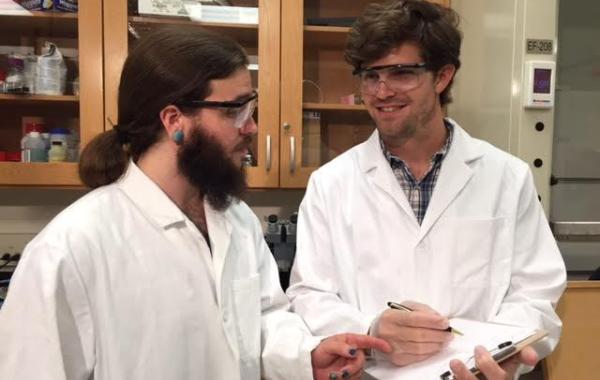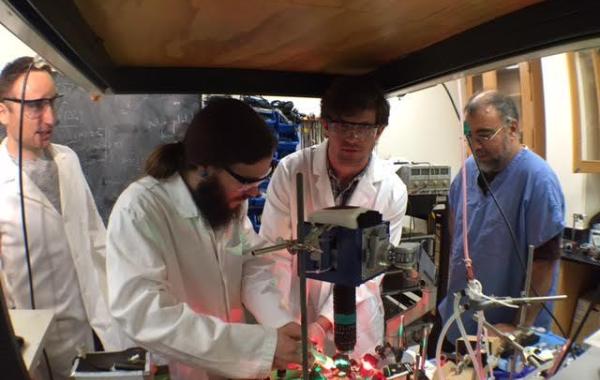A Physics Dream Comes True in the CHAOS Lab

The CHAOS (Complex Heart Arrhythmias and other Oscillating Systems) lab has an open-door policy for the curious. Led by School of Physics Associate Professor Flavio H. Fenton, the lab aims to understand the physics of irregular heartbeats, which can lead to heart disease. Using high-performance computing, mathematical modeling, and experiments with live hearts infused with dyes and photographed by ultrafast cameras, the researchers here are discovering the dynamics of the heart as a complex system
Work in the CHAOS lab involves real hearts of various animals, including the zebra fish. Adults of this tropical freshwater fish measure about 5 cm in length. Viewed through a microscope, the tiny zebra fish heart looks like a raspberry. Seen with the naked eye, the beating organ looks like the tip of a small red ball-point pen.
Extracting the heart and then observing its electrical pathways requires require dexterity and precision.
James T. “Tim” Farmer, an undergraduate researcher, has these skills. Visit the lab and you might see him delicately removing the heart of a tiny fish and then bathing the fragile heart with a dye solution to help monitor electrical pathways. In an inner room, he sets up the cameras, lenses, and electronics he will use to observe signals from a teeny fish heart.
Amid shiny lab instruments, clear glass bottles filled with colored liquids, and the sounds of a humming lab, Farmer quickly sets up the heart for experiments. It’s obvious he has done this routine many times.
If you met Farmer when he was a high school sophomore, the CHAOS lab is not where you would have imagined seeing him today. If you knew that his high-school grade point average (GPA) is 1.6, you would be wondering how he made it to Georgia Tech.
Farmer, now 25, will graduate with a B.S. in Physics in May 2017. He has come a long way from his chaotic early life through self-motivation.
PHYSICS OF CARDIAC DISEASE
With Fenton and Ph.D. student Conner J. Herndon, Farmer is characterizing the complex dynamics of the zebra fish heart. Specifically, they are examining the phenomenon called “alternans” in the zebra fish heart.
Alternans is known to cause arrhythmias in hearts, Fenton says. “It is particularly known as a mechanism for sudden cardiac death, which kills more than 300,000 people annually in the U.S,” he adds.
The phenomenon can be induced by applying a voltage to the organ. Initially the heart beats in rhythm with the voltage frequency, but as the frequency increases, the heart must adapt to keep pace. Instead of beating rhythmically, the heart oscillates strongly between big and small (12 12) heart beats. As the frequency increases even more, the adaptation devolves, doubling the number of states involved in each period; that is, 12 12 becomes 1234 1234 and then 12345678 12345678 and so on into chaos.
Alternans can be described mathematically, Herndon says. “What if ventricular fibrillation is just chaos?” he asks. “What if we can mathematically derive the pathway to chaos? Because if you can, maybe you can stop it.” And because fibrillations—or irregular contractions—can cause heart attacks, the research could lead to prevention of heart disease.
LIFE BEFORE GEORGIA TECH
“I didn’t come from a stable family,” Farmer says. “My parents did a lot of drugs. We moved a lot, once or twice every year until I was 18, and then I joined the Navy.”
Although born in Tennessee, Farmer has lived off and on in Georgia and considers the state his home. Many members of his family live south of Atlanta, along I-75 between Stockbridge and Jackson. The last high school he attended was Luella High School, in Locust Grove, Georgia.
Despite the topsy-turvy upbringing, Farmer says, he did well academically until high school. “Like other teenagers, I went through a rebellious phase,” he recalls. “No one in my family went to college. I didn’t even know how to apply or that financial assistance was available outside of scholarships. I didn’t see college as an opportunity available to me, so I didn’t care about my grades. I skipped a lot of classes in 9th and 10th grade, hanging out with the punk kids.”
After the 10th grade, however, Farmer decided that he wanted a better life. After considering his options, he concluded that joining the U.S. Navy would be “an opportunity to do something better with my life.”
When he was wrapping up with the Navy, Farmer started looking for schools. “I wanted to go to the best school in Georgia,” he recalls. “By far, Georgia Tech was the best.”
DREAMS COME TRUE IN GEORGIA TECH
With a 1.6 GPA, Farmer couldn’t go straight to Tech. He enrolled in Middle Georgia State University to study engineering. But his heart was really in physics. With guidance from his physics professor, Malav Shah, he decided to follow his heart and pursue physics at his dream school. Farmer moved to Tech after his sophomore year.
On his first week at Tech, Herndon hired Farmer to do undergraduate research in the CHAOS lab.
Farmer’s Navy experience was a huge advantage, Herndon says. “With undergrads fresh out of high school, you don’t really know how they’ll work,” he says. “Tim had already worked in the Navy for four years. He had been trained to do a job, and he had a background in electronics. That’s why I brought him in.”
In the CHAOS lab, Farmer has exceeded expectations. He has created a lens system to optically map the propagation of voltage and calcium, performed experiments on zebra fish hearts, and worked on the mathematical theory of alternans. He has coauthored presentations and published papers, including “Electrocardiogram Reconstruction from High Resolution Voltage Optical Mapping.”
“Tim is a very smart student,” Fenton says. “He has required relatively little supervision.”
“Tim has by far the most self-motivation of any undergraduate I have worked with,” Herndon says. “I just gave him the end goal, and he found a way to get there.
“Tim has been beneficial to us in other ways,” Herndon adds. “He’s been working with me on theory projects. Immediately after joining the lab, he was helping me on my Ph.D. project, reading papers with me, discussing and working through the math with me.”
By cobbling together financial support from various sources, Farmer is realizing his dream of a B.S. Physics degree from Georgia Tech. He works as a bartender/caterer, as well as a valet. He took out a Federal Pell Grant and successfully applied for a Georgia Hope Scholarship. Other scholarships play a key role, including Georgia Tech’s Presidents’ Undergraduate Research Award(PURA), the College of Sciences’ Undergraduate Research in Science Award (URSA), and a National Science Foundation Research Experiences for Undergraduates (REU) award.
Now Farmer is thinking ahead. He is researching graduate schools and deciding what type of physics to study for his Ph.D.
He might go further into nonlinear dynamics, which is related to the zebra fish research. But he also likes astrophysics. “I’ve been interested in space since I was a kid,” Farmer says. “I’m interested in the structure and evolution of the universe.”
He must apply to graduate school by December 2016.
“Wherever Tim lands after Georgia Tech would be lucky to have him,” Fenton says. “His self-motivation knows no bounds.”
Dione Morton* and A. Maureen Rouhi
College of Sciences
*Dione Morton joined the Renewable Bioproducts Institute on Oct. 17, 2016.

